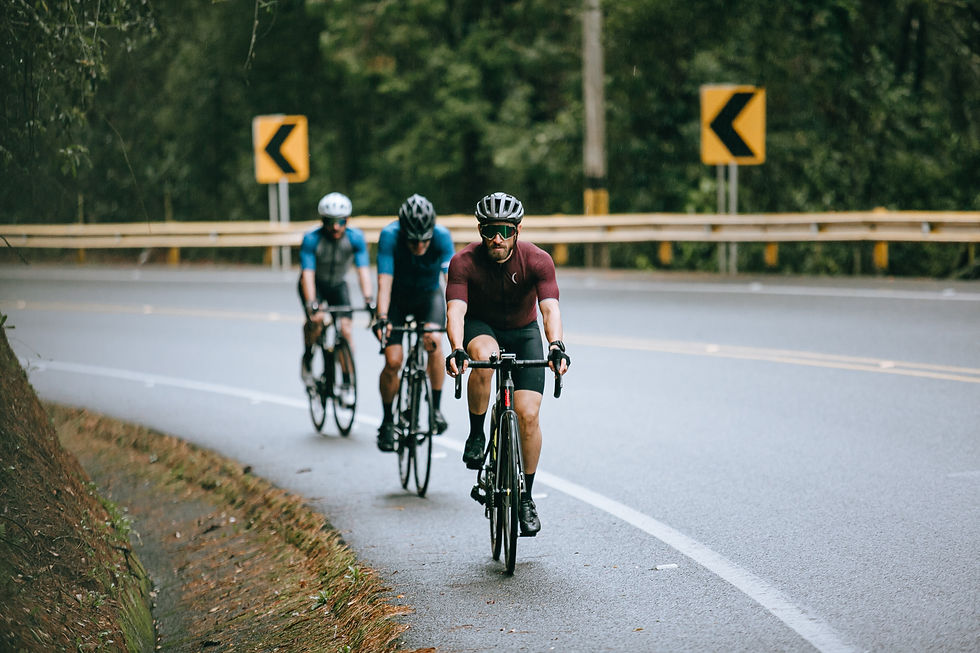Hill Reps - The Details
- Jonathan Melville

- Jun 3
- 3 min read
There can be a lot more to hill repeats than just running or cycling up and down a hill. Lets anwser some frequency askded questions.

What Are Hill Repeats?
Hill repeats are short to medium-length efforts performed uphill, typically repeated several times with easy recovery (the downhill) in between. They can last anywhere from 30 seconds to 5 minutes, depending on your training goals. For runners, they’re done on a steady gradient road or trail; for cyclists, on a climb that allows seated or standing efforts with consistent gearing. These sessions are not only about leg strength — they target aerobic and anaerobic capacity and neuromuscular coordination.
What Are the Benefits of Hill Repeats?
Hill training is often referred to as “strength training in disguise.” Here’s why:
Muscular Strength and Endurance: Climbing forces you to recruit more muscle fibres with every stride or pedal stroke.
Improved Running Economy / Pedalling Efficiency: You develop better mechanics and force production at slower speeds or lower cadences.
VO₂max and Anaerobic Power: Short, hard hill reps push your heart rate and oxygen uptake quickly, building cardiovascular fitness.
For cyclists, hill repeats also improve your power-to-weight ratio, especially helpful for climbing stages or surges in group rides.
How Long Should a Hill Repeat Be?
The length depends on your goal:
Type | Duration | Focus |
Short Repeats | 30–60 sec | Anaerobic power, speed, form |
Long Repeats | 2–5 min | Strength, aerobic power |
Shorter reps = higher intensity and powerLonger reps = more aerobic, fatigue resistance under load
What Gradient Should I Use?
Ideally, pick a hill with a moderate, consistent gradient:
Runners: 4–8% works well — steep enough to challenge, but not so steep that form breaks down
Cyclists: 5–7% allows for either seated or standing climbing and good control of power output
Avoid technical descents or uneven surfaces (unless you are a trail runner) — especially for hard running efforts where downhill injuries can occur.
How Much Recovery Should I Take Between Repeats?
For most hill sessions, full or near-full recovery is recommended so you can maintain good form and high effort:
Short hills: 1–2 minutes walking or easy jogging (or downhill coasting for cyclists)
Longer hills: 2–4 minutes of easy aerobic recovery
This ensures each repeat is high quality. If the focus is aerobic endurance, you can shorten recovery — but for strength and power, more rest gives better adaptation.
How Often Should I Do Hill Repeats?
Hill repeats are demanding — both musculoskeletally and metabolically — so 1 session every 7–14 days is usually enough, depending on your training phase.
They’re best used in:
Base phase: to build foundational strength
Pre-season/pre-race blocks: to sharpen climbing ability
As race-specific prep: for hilly courses or off-road terrain
Can Beginners Do Hill Repeats?
Absolutely — but volume and intensity need to be adjusted. For runners, start with 4 x 30 seconds and focus on relaxed form, not all-out effort. For cyclists, start with 3–4 x 2-minute climbs at moderate intensity and build week by week. The emphasis for beginners should be on technique, posture, and pacing — not max power or heart rate.
Examples of Hill Repeat Workouts
Runners:
Short Hill Repeats: 8 x 30 sec @ 95% effort, walk/jog back down
Medium Repeats: 6 x 2 min uphill, easy jog down
Hill Tempo + Repeats: 15 min steady uphill run + 4 x 45 sec fast strides uphill
Cyclists:
Strength Repeats: 5 x 3 min @ 70–80 RPM in a big gear, seated, 3 min spin down
Power Repeats: 8 x 45 sec standing hard uphill @ >100% FTP, 2 min easy spin
Tempo Climb Blocks: 2 x 8 min @ tempo effort climbing, 4 min recovery
Each of these sessions targets slightly different adaptations — from max force to sustainable climbing strength.
Are Downhill Repeats Worth Doing?
For runners, the downhill segment can provide eccentric loading that strengthens tendons and joints — but it’s also where most impact-related injuries occur. If you're not experienced or haven't built up the mileage, avoid fast downhill repeats.
Cyclists generally use the descent for recovery. However, practicing descending skills (e.g., cornering, braking) during easier sessions is highly valuable — especially for those racing, but be careful.
If you have more questions, please don't hesitate to ask.
Email: info@breakaway-coaching.com







Comments